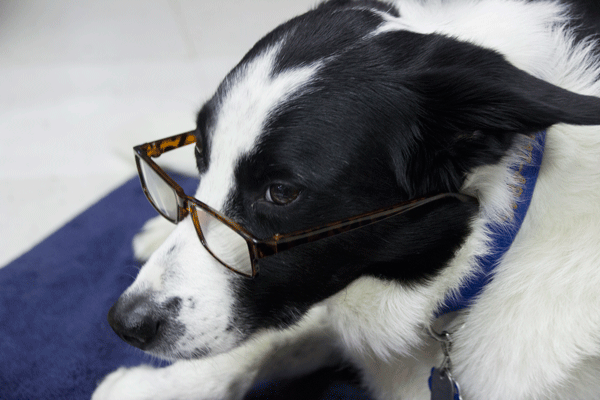
We all know dogs can’t read.
That’s why children at New Paltz’s Elting Memorial Library (EML) read to them.
This is part of a nationwide effort to improve the literacy skills of children. EML’s independent, non-research-based program is called the Reading to Dogs program – and SUNY New Paltz’s very own Augie the Border Collie is lucky enough to have been a part of this program since its inception in the summer of 2012.
When SUNY New Paltz Environmental Health & Safety Director Michael Malloy got Augie from Big Ben Farms in Virginia, his only intentions for the dog were for him to get rid of the geese on campus. Augie didn’t get involved in the Reading to Dogs program until years later.
Malloy said Augie has been a part of the program for about four years and is the longest-participating dog at EML.
“Augie is the perfect match for children’s reading,” he said. “He is the gentlest, most tolerable dog I’ve ever met. He has a good temperament and I’ve never seen him get aggressive with humans.”
Malloy said Augie looks at the children while they’re reading to him, nuzzles himself against them, puts his paws on them, puts his head against their shoulders or in their lap and comforts them.
“Children feel they are able to express themselves to a warm, friendly object [like a dog] that will not give them negative feedback,” he said. “That way they can make mistakes, they can hear themselves read and they feel more comfortable. This dog exudes comfort.”
Several New Paltz children between the ages of four and eight go to the library to read to Augie or one of the other trained service dogs. Currently, however, Augie is the only service dog at EML. One dog recently retired, and the library is in the process of hiring another.
Not only are the children more comfortable reading to the dogs than adults, but the dogs appear to be interested in the reading.
Malloy said the book that Augie responds most to is “Augie Goes to College” written by Rachel Rigolino, a lecturer in the English department at SUNY New Paltz.
“Augie loves to hear his name,” Malloy said. “And he loves the attention from the kids.”
During the fall, the program takes place on one Saturday in October and November, in the spring on one Saturday during March, April and May and during the summer the program runs for seven weeks straight.
Malloy remembered one 5-year-old reader in particular, Matei Jirka. When he started reading to the dogs a year ago, he was already a beginning reader; but in Russian, not English.
He struggled with knowing when to pause at the end of a sentence or when starting a new paragraph. Malloy and Jirka’s mother decided to try a play on words to help him. Every time a sentence would end, he would touch Augie’s paw to pause. Whenever an entire paragraph would end, he would touch both of his paws to signify a longer pause.
Through this program, Jirka transitioned into an English-speaking reader from merely telling stories to the dogs in Russian based on pictures.
Since Malloy and Augie joined the Reading to Dogs program, they have seen many children improve. He said that some of the kids who were beginner readers four years ago are helping to run the program now as part of the 5-6-7 Advisory Group and Teen Advisory Group.
Linda Welles, the vice president of the Board of Trustees at the EML, said that this program helps create a sense of responsibility for the older children and teens. Often times, before the beginner readers read with the dogs, the advisory groups will read with them to give them more practice and to help them feel more comfortable.
When the children are done reading to the dogs, the advisory groups create paper dog bones with the child’s name written on it, including which dog they read to. This shows the steps that the children have taken toward becoming better readers as well as their progress. At the end of the reading sessions, the children give the dogs a piece of a dog treat to show their appreciation for sitting and listening.
A study from the University of California at Davis reported that young readers who took part in a 10-week reading program with dogs improved their reading skills by 12 percent. On the contrary, children in the same program who didn’t read to dogs showed no improvement.
“This program gives children a comfortable, nonjudgmental environment to read in,” Welles said. “The dogs don’t care if the kids read slow or make up the story.”
The next Reading to Dogs program is scheduled for this coming Saturday, Oct. 24 from 11 a.m. to 12:30 p.m. and Augie will definitely be there.
